The Automotive Seating Market is estimated to be valued at USD 74.1 billion in 2025 and is projected to reach USD 106.6 billion by 2035, registering a compound annual growth rate (CAGR) of 3.7% over the forecast period.
The automotive seating market is experiencing steady expansion driven by rising vehicle production, growing consumer preference for enhanced comfort, and increasing adoption of advanced ergonomic designs. Market dynamics are being influenced by evolving safety regulations, lightweight material innovations, and the integration of electronic and smart adjustment systems.
Manufacturers are focusing on modular seat structures and sustainable materials to reduce weight and improve fuel efficiency. Demand from both passenger and commercial vehicle segments remains strong due to continuous upgrades in vehicle interiors and growing emphasis on driver and passenger comfort.
The future outlook indicates sustained growth supported by electric vehicle adoption, premium segment expansion, and ongoing R&D investments in smart and ventilated seating technologies The growth rationale rests on the rising need for customized seating configurations, improved manufacturing automation, and strong OEM partnerships that ensure consistent supply and large-scale integration across vehicle categories worldwide.
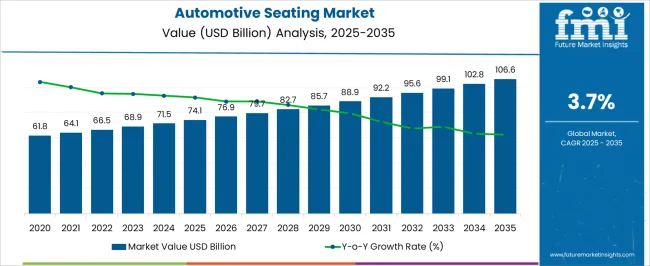
| Metric | Value |
|---|---|
| Automotive Seating Market Estimated Value in (2025 E) | USD 74.1 billion |
| Automotive Seating Market Forecast Value in (2035 F) | USD 106.6 billion |
| Forecast CAGR (2025 to 2035) | 3.7% |
The market is segmented by Seat Type, Vehicle Type, and Distribution Channel and region. By Seat Type, the market is divided into Split Seat, Bench Seat, and Split Bench Seat. In terms of Vehicle Type, the market is classified into PCV (Passenger Commercial Vehicles), LCV (Light Commercial Vehicles), and HCV (Heavy Commercial Vehicles). Based on Distribution Channel, the market is segmented into OEM and Aftermarket. Regionally, the market is classified into North America, Latin America, Western Europe, Eastern Europe, Balkan & Baltic Countries, Russia & Belarus, Central Asia, East Asia, South Asia & Pacific, and the Middle East & Africa.
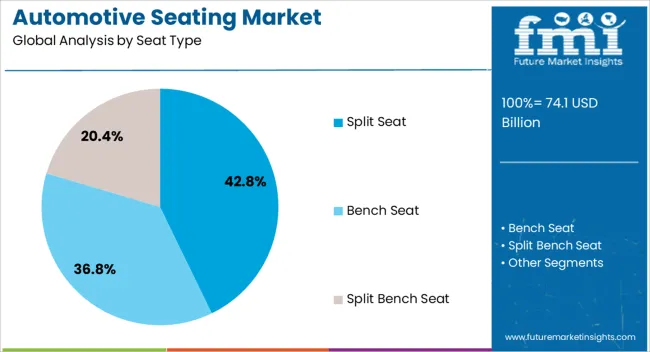
The split seat segment, accounting for 42.80% of the seat type category, has emerged as the leading configuration due to its flexibility, comfort, and efficient space utilization. Its design allows for adjustable seating arrangements that cater to diverse passenger needs, enhancing overall vehicle functionality.
The segment’s dominance has been driven by high adoption in SUVs, MPVs, and crossovers where modular interior layouts are prioritized. Advances in seat folding mechanisms and lightweight frame structures have further increased adoption across mid-range and premium vehicles.
Continuous improvement in upholstery materials and inclusion of additional comfort features such as lumbar support and heating have strengthened its market presence The segment is expected to sustain growth through technological enhancements, increasing vehicle customization trends, and rising consumer demand for adaptive seating systems.
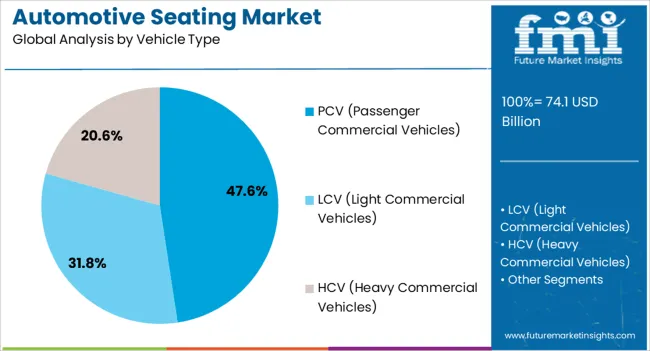
The PCV (Passenger Commercial Vehicles) segment, representing 47.60% of the vehicle type category, is maintaining its leading position due to the expanding global passenger vehicle fleet and growing demand for enhanced interior comfort. The segment benefits from consistent production volumes across developing economies and premium vehicle launches in mature markets.
Increasing focus on occupant safety, noise reduction, and thermal comfort has reinforced the adoption of advanced seat technologies in passenger vehicles. OEMs are investing in integrated seat sensors, smart adjustment systems, and improved material durability to enhance comfort and safety.
Demand is further supported by the trend of long-distance commuting and growing middle-class vehicle ownership, positioning this segment for sustained dominance over the forecast period.
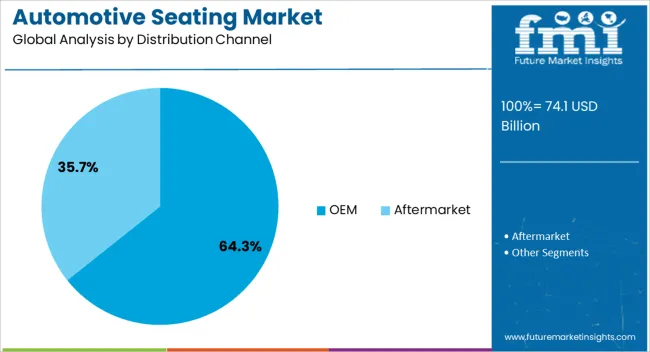
The OEM segment, holding 64.30% of the distribution channel category, continues to lead due to strong collaborations between seat manufacturers and automotive OEMs for integrated design and production. The dominance of this channel is driven by bulk procurement contracts, adherence to stringent quality standards, and seamless integration within vehicle assembly lines.
OEMs are leveraging strategic partnerships with seating system suppliers to ensure design uniformity and cost efficiency while integrating advanced comfort and safety features. Continuous R&D investments by OEMs in smart seating and modular configurations have enhanced market competitiveness.
With growing electric and autonomous vehicle development, OEMs are expected to maintain their leadership through technology-driven seating innovations and increased localization of manufacturing facilities to optimize production and supply chain efficiency.
Between 2020 and 2025, the automotive seating market experienced a CAGR of 3.04%. This indicates moderate growth over this period.
Looking ahead to the forecasted period from 2025 to 2035, the market is expected to see an increase in growth rate, with a projected CAGR of 3.7%. This suggests a slightly faster expansion pace than the previous five years.
The historical analysis reflects a steady but relatively modest growth trajectory, while the forecasted projections indicate a slightly accelerated market growth pace over the coming decade.
Technological advancements could influence this, increasing demand for comfort and safety features, evolving consumer preferences, and the integration of seating innovations into emerging automotive trends like electric and autonomous vehicles.Top of Form
| Historical CAGR from 2020 to 2025 | 3.04% |
|---|---|
| Forecast CAGR from 2025 to 2035 | 3.7% |
The table showcases the top five countries ranked by revenue, with China holding the top position.
China has the largest automotive industry globally, with a massive domestic market and significant export capabilities. The automotive sector benefits from robust manufacturing infrastructure, economies of scale, and extensive supply chains.
The automotive seating manufacturers can leverage these advantages to produce a wide range of seating systems efficiently and cost-effectively, meeting both domestic and international demand.
| Countries | Forecast CAGRs from 2025 to 2035 |
|---|---|
| United States | 2.3% |
| Canada | 3.1% |
| South Korea | 3.8% |
| China | 4.6% |
| India | 4.2% |
The utilization of automotive seating in the United States is facilitated by the stringent safety regulations enforced by organizations like the National Highway Traffic Safety Administration (NHTSA).
These regulations mandate specific safety standards for automotive seating, including requirements for seat strength, occupant protection, and crashworthiness.
Manufacturers in the United States must comply with these regulations to ensure that their seating systems meet the necessary safety standards, driving the demand for advanced seating technologies and innovations in the market.
The cold climate conditions are a significant reason for using automotive seating in Canada. With long winters and low temperatures, there is a heightened demand for automotive seating equipped with features such as seat heaters and heated cushions to provide comfort and warmth to drivers and passengers.
Automotive seating manufacturers in Canada cater to this demand by producing seating systems with cold-weather features, driving the market forward.
The utilization of automotive seating in South Korea focuses on innovation and technological advancements. Automotive manufacturers are known for their cutting-edge research and development capabilities, leading to the integration of advanced features and technologies into automotive seating systems.
Innovations include smart seating controls, advanced air ventilation systems, and ergonomic designs tailored for enhanced comfort and support. The emphasis on innovation drives the demand for automotive seating in South Korea.
A key reason for using automotive seating in China is the rapid growth of the automotive industry. China is the largest automotive market globally, with a burgeoning demand for passenger and commercial vehicles.
As the automotive market continues to expand, there is a proportional increase in the demand for automotive seating to equip these vehicles. This vehicle production and sales growth drives the demand for automotive seating in China.
One major reason for using automotive seating in India is the increasing focus on comfort and convenience among consumers. With rising disposable income and evolving lifestyle preferences, Indian consumers increasingly prioritize comfort and convenience features in their vehicles, including seating systems.
The country has led to a growing demand for automotive seating with features such as adjustable lumbar support, ergonomic designs, and premium upholstery materials. The focus on comfort and convenience drives the demand for automotive seating in the market.
The below section shows the leading segment. Based on seat type, the spilt segment is accounted to hold a market share of 65.8% in 2025. Based on vehicle type, the passenger cars segment is anticipated to account for a market share of 77.2% in 2025.
Split seating configurations, such as bench seats or individually adjustable seats, allow passengers to customize their seating arrangement based on comfort preferences, passenger capacity, or cargo requirements.
With the rising expectations for a pleasant driving experience, automakers prioritize equipping passenger cars with ergonomic seating designs, adjustable features, and premium materials to enhance comfort levels for occupants.
| Category | Market Share in 2025 |
|---|---|
| Split | 65.8% |
| Passenger Cars | 77.2% |
The split segment, which includes different seating configurations such as bench seats, captain chairs, and individual seats, is expected to hold a significant market share of 65.8% in 2025. This indicates that most automotive seating sold in the market will belong to this category.
The split segment caters to diverse consumer preferences and vehicle designs, offering flexibility in seating arrangements to accommodate varying passenger capacities and cargo needs.
Consumers can choose various seating options based on their specific requirements, whether optimizing passenger space, enhancing comfort, or facilitating easy access to the interiors of the vehicle.
The passenger cars segment is projected to dominate, with a market share of 77.2% in 2025. This segment includes various types of passenger vehicles, such as sedans, hatchbacks, and SUVs, widely used for personal transportation.
Passenger cars typically require comfortable and ergonomic seating systems to provide a pleasant driving experience for occupants during daily commutes or long journeys.
The strong market share of passenger cars underscores their prominence in the automotive industry and highlights the significant demand for seating solutions tailored to meet the needs of individual vehicle owners and passengers.
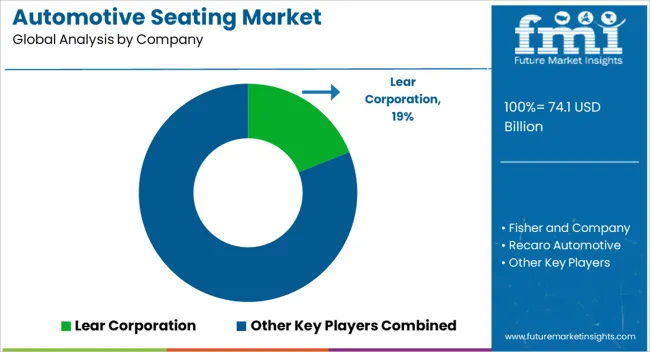
The competitive landscape of the automotive seating market is characterized by several key players vying for market share through product innovation, strategic partnerships, and geographic expansion.
Regional players and niche manufacturers contribute to the competitive dynamics, offering specialized seating solutions and catering to specific market segments. Continuous efforts to enhance product quality, safety, and comfort, focusing on sustainability and cost efficiency, drive competitiveness within the market.
Some of the key developments
| Attributes | Details |
|---|---|
| Estimated Market Size in 2025 | USD 74.1 billion |
| Projected Market Valuation in 2035 | USD 106.6 billion |
| Value-based CAGR 2025 to 2035 | 3.7% |
| Forecast Period | 2025 to 2035 |
| Historical Data Available for | 2020 to 2025 |
| Market Analysis | Value in USD billion |
| Key Regions Covered | North America; Latin America; Western Europe; Eastern Europe; South Asia and Pacific; East Asia; Middle East and Africa |
| Key Market Segments Covered | Seat Type, Vehicle Type, Distribution Channel, Region |
| Key Countries Profiled | The United States, Canada, Brazil, Mexico, Germany, The United Kingdom, France, Spain, Italy, Russia, Poland, Czech Republic, Romania, India, Bangladesh, Australia, New Zealand, China, Japan, South Korea, GCC countries, South Africa, Israel |
| Key Companies Profiled | Fisher and Company; Recaro Automotive; Faurecia; Grammar Seating Systems; Johnson Controls; TM Automotive Seating Systems Private Limited; Lear Corporation; Tata Autocomp Systems Limited; Toyota Boshoku Corporation; Marter Automotive Seating Systems; TS Tech Corporation Ltd. |
The global automotive seating market is estimated to be valued at USD 74.1 billion in 2025.
The market size for the automotive seating market is projected to reach USD 106.6 billion by 2035.
The automotive seating market is expected to grow at a 3.7% CAGR between 2025 and 2035.
The key product types in automotive seating market are split seat, bench seat and split bench seat.
In terms of vehicle type, pcv (passenger commercial vehicles) segment to command 47.6% share in the automotive seating market in 2025.






Full Research Suite comprises of:
Market outlook & trends analysis
Interviews & case studies
Strategic recommendations
Vendor profiles & capabilities analysis
5-year forecasts
8 regions and 60+ country-level data splits
Market segment data splits
12 months of continuous data updates
DELIVERED AS:
PDF EXCEL ONLINE
Automotive seating accessories Market Size and Share Forecast Outlook 2025 to 2035
Automotive Seating Systems Market Analysis - Size, Share & Forecast 2025 to 2035
Automotive Performance Part Market Size and Share Forecast Outlook 2025 to 2035
Automotive Carbon Ceramic Brake Market Size and Share Forecast Outlook 2025 to 2035
Automotive Camshaft Market Size and Share Forecast Outlook 2025 to 2035
Automotive Stamping Industry Analysis in India Size and Share Forecast Outlook 2025 to 2035
Automotive Cylinder Liner Market Size and Share Forecast Outlook 2025 to 2035
Automotive Microcontroller Market Size and Share Forecast Outlook 2025 to 2035
Automotive Roof Rails Market Size and Share Forecast Outlook 2025 to 2035
Automotive Active Safety System Market Size and Share Forecast Outlook 2025 to 2035
Automotive Diagnostic Scan Tool Market Size and Share Forecast Outlook 2025 to 2035
Automotive Test Equipment Market Size and Share Forecast Outlook 2025 to 2035
Automotive Dynamic Map Data Market Size and Share Forecast Outlook 2025 to 2035
Automotive Green Tires Market Size and Share Forecast Outlook 2025 to 2035
Automotive E-Tailing Market Size and Share Forecast Outlook 2025 to 2035
Automotive Interior Market Forecast Outlook 2025 to 2035
Automotive Key Market Size and Share Forecast Outlook 2025 to 2035
Automotive Appearance Chemical Market Forecast and Outlook 2025 to 2035
Automotive Domain Control Module Market Forecast and Outlook 2025 to 2035
Automotive Remote Diagnostic Market Forecast and Outlook 2025 to 2035

Thank you!
You will receive an email from our Business Development Manager. Please be sure to check your SPAM/JUNK folder too.
Chat With
MaRIA